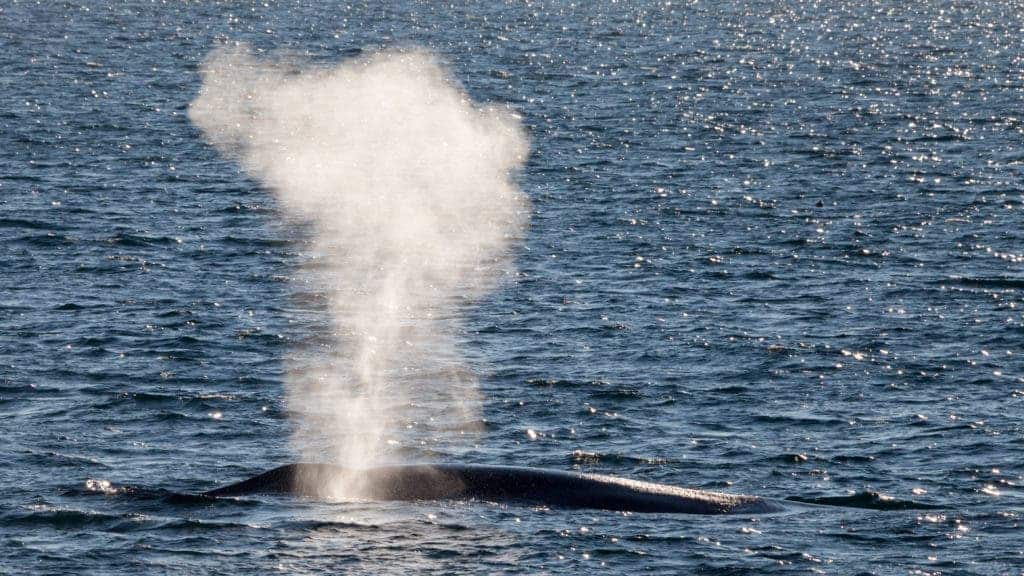Blue whales eat krill — a lot of it, as it’s not easy to power a basketball-court-sized animal weighing as much as 25 elephants. It is estimated to take 2,200 pounds (1 metric ton) of food to fill a blue whale’s stomach, and during peak consumption periods, they can devour up to 8,000 pounds (3.6 tons) in a single day.
Now scientists have found how they know where to get it.
Government and university researchers have been examining records of both whale migration and oceanic conditions in the California Current Ecosystem — a coastal upwelling biome, one of the richest and most productive marine ecosystems. Researchers found that blue whales almost perfectly match the timing of their migration to the historical average timing of krill production, rather than matching the waves of krill availability in any given year. The study, which was published in the Proceedings of the National Academy of Sciences (PNAS), found that blue whales rely heavily on their memory in making these movement decisions.
The team used a decade’s worth of tagging data from the Marine Mammal Institute at Oregon State University to determine daily blue whale movements of 60 individual whales. They then compared that with satellite-based measurements of ocean productivity.
There are an estimated 10,000 blue whales in the world, and a quarter of them spend time in the waters off the west coast of the Americas. They travel from the Gulf of Alaska all the way down to an area near the equator known as the Costa Rica Dome. This range makes them quite vulnerable in the face of commercial ships, and it’s unclear exactly just how they came to use these migration routes.
“We think that blue whales have evolved to use historical migration routes and timing that put them in proximity to the most predictably high production feeding areas and then make minor adjustments based on local conditions,” said Daniel Palacios, a principal investigator with Oregon State’s Marine Mammal Institute and a co-author on the study.
“There are various time scales of events that could change the timing of phytoplankton blooms – and thus the availability of the whales’s preferred prey, krill”, he noted, “including La Nina and El Nino events and the Pacific Decadal Oscillation. But the whales’ strategy of relying on memory and historic timing at least gets them into the ‘Goldilocks zone'”.
The study is one of the first to determine how, precisely, ocean life tracks their food. Like whales, countless land species might migrate long distances for their meals. Unlike whales, those species adjust their courses to find the food. Whales, it seems, just go back to the same grocery they went to before.
“We know that many species that migrate on land, from caribou in the Arctic to wildebeests in the Serengeti, enhance their survival by carefully adjusting the pace and timing of their migrations to find food as it becomes seasonally available along the way, rather than just migrating to get from point A to point B,” said Briana Abrahms, a research ecologist with the NOAA Southwest Fisheries Science Center in Monterey, CA, and lead author on the study.
The blue whale is the largest known creature to ever inhabit the Earth but up until very recently, almost nothing was known about its mating and migration routes. Oregon State’s Bruce Mate changed all that, leading a series of tracking studies, but our understanding of blue whale ecology is still quite low. An extra incentive to study them now is climate change. Whales might find it difficult to adapt to ecosystem changes that result from it, said Abrahms.
“With climate change, we’re seeing deviations from those averages that are far outside of the normal ranges of variability,” she said. “It raises concern that the magnitude of change is happening far more quickly than what whales or other animals ever had to adapt to before. We still have a lot to learn about how large animals navigate in the ocean, how they find good habitat and how they are affected by human activities and environmental changes.”
Understanding how blue whales make movement decisions give scientists insight into how whales may, or may not, be able to cope with changing ocean conditions in the future.
Journal Reference: Abrams et al. Memory and resource tracking drive blue whale migrations. Proceedings of the National Academy of Sciences, 2019; 201819031 DOI: 10.1073/pnas.1819031116










